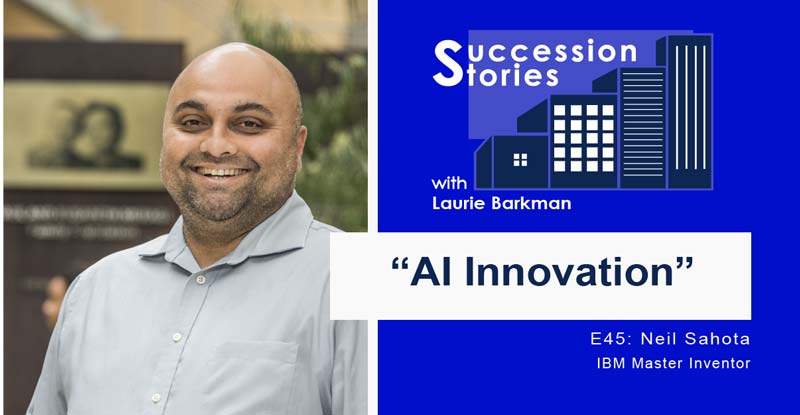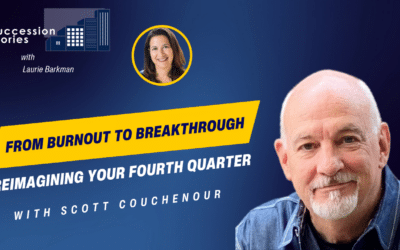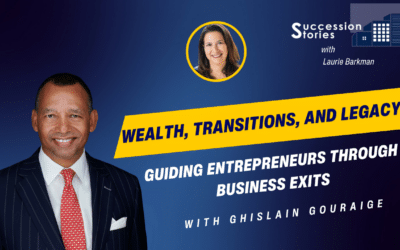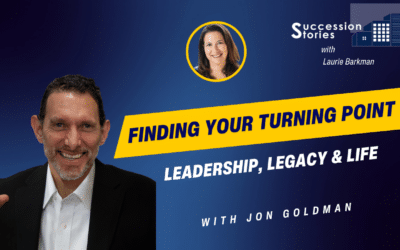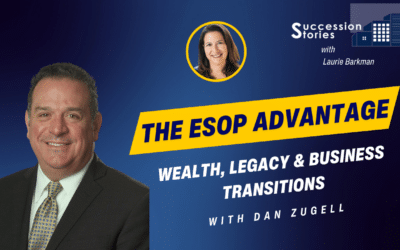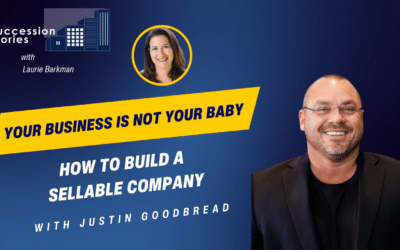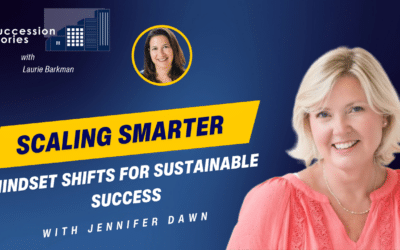Listen to the audio:
Neil Sahota helped create the artificial intelligence ecosystem that famously won Jeopardy called Watson. He’s an IBM Master Inventor and artificial intelligence subject matter expert with the United Nations. Neil’s written a book called Own the AI Revolution. We talked about ways to learn about AI so we don’t fear the changes it can bring. AI is doing a lot of good around the world and there are practical business applications. Is AI out of reach for small to mid-sized companies? Listen in to hear Neil’s thoughts on that question, and what it could mean for your company.
Listen in to learn more about:
- Whether AI is ideal for smaller and mid-sized companies
- The capabilities and limitations of AI
- Adapting AI for different use cases
- Why Ai is actually good for the job market
- How AI is driving the United Nations Sustainable Development Goals (SDGs)
Show links:
Neil Sahota on LinkedIn:
https://www.linkedin.com/in/neilsahota
Neil’s book Own the AI Revolution on Amazon
Connect with the host, Laurie Barkman on SmallDotBig.com and sign-up for an insights newsletter to build value in your company.
Full transcript:
Laurie Barkman:
Welcome to Succession Stories insights for next-generation entrepreneurs. I’m Laurie Barkman. I’ve spent my career bringing an entrepreneurial approach to mature companies struggling with change. As an outside executive of a third-generation 120-year-old company, I was part of a long-term succession plan. Now I work with entrepreneurs privately held companies and family businesses to develop innovations that create enterprise value in transition plans to achieve their long-term goals. On this podcast, listen in while I talk with entrepreneurs who are driving innovation and culture change. I speak with owners who successfully transition their company and others who experienced disappointment along the way. Guests also include experts in multi-generational businesses and entrepreneurship. If you are a next-generation entrepreneur, looking for inspiration to grow and thrive, or an owner who can’t figure out the best way to transition their closely held company, this podcast is for you.
What if your company could unlock millions from your data? If you’re interested in exploring how machine learning and other frontier technologies can be a catalyst for revenue or increased profits in your business, let’s connect. Our process helps create an identified solution in just two days! Go to smalldotbig.com/contact to start the conversation. Go to smalldotbig.com/contact today.
Be sure to subscribe to get future Succession Stories episodes directly in your preferred podcast player and follow the show on LinkedIn.
Laurie Barkman:
Neil Sahota helped create the artificial intelligence ecosystem that famously won Jeopardy called Watson. He’s an IBM Master Inventor and artificial intelligence subject matter expert with the United Nations. Neil’s written a book called Own the AI Revolution. We talked about ways to learn about AI so we don’t fear the changes it can bring. AI is doing a lot of good around the world and there are practical business applications. Is AI out of reach for small to mid-sized companies? Listen in to hear Neil’s thoughts on that question, and what it could mean for your company.
Laurie Barkman:
Neil Sahota, a big part of your book and underlying message is about thinking differently. I’m looking forward to hearing more about that and how business owners can make AI actionable, especially in the lower middle market. Welcome!
Neil Sahota:
Hey, thanks for having me Laurie, I’m really looking forward to a lively conversation.
Laurie Barkman:
Great. Why don’t we start, Neil, why don’t you tell us about you, and how you got involved with IBM Watson and ultimately, the United Nations?
Neil Sahota:
Well, I’ve always been the kind of guy that likes to solve problems, not just the problems at hand, but the ones that are a little more general. Fifteen years ago, business intelligence was all the rage. Working with people like Michael Iser and Warren Buffett, Howard Schultz. They were all telling me, “Neil, it’s amazing what the computers are telling us.” I’m thinking to myself, “Computers aren’t actually telling us anything. They are sweet tools that help us collect data, store it, slice and dice it and create nice-looking reports, but can a machine actually think about the data and give us insights?” And so I wanted to create a lot of intellectual capital around that. Paths and such that actually netted the attention of IBM R&D. We had a discussion, they asked me to join what then was a secret project codenamed Watson. So that’s how I ended up joining the Watson team.
We did the “Jeopardy Challenge,” and to everyone’s surprise, including our own, Watson won. Then the big question became, “What are you guys gonna do with this, because we spent a lot of money and a lot of time working on this?” and we said, “We’ll have to get back to you, because we haven’t thought that far out.” So I was one of the people that was advocating opening up the technology, really stirring the ecosystem; let the people that understand the problems, let’s partner with them to actually build ventures and solutions.
Not just provide the technical stuff – let’s partner together to figure out the business model or agency, nonprofit service model for the people that are trying to help. I wound up building up to about 30,000 organizations when I got the attention of the United Nations who asked me to come speak at a big signature event. They warned me all the world leaders think that AI is “Terminator Time.” The machines are gonna rise up, conquer the world, eradicate humanity, so I had a bit more of an uplifting speech. I talked about what AI is and how it actually has been used for public service and how it can be applied towards the United Nations Sustainable Development Goals. That seemed to resonate pretty well, so that evening at the reception, the Secretary-General approached me like, “Neil, you opened our eyes. We never actually thought about using the technology for good. Got a lot of momentum here and I want to figure something out.” That’s what led me to co-create the AI for Good initiative and why I ended up becoming the UN’s AI Advisor.
Laurie Barkman:
That’s an incredible story. It’s so relatable because I think so many people have the Terminator in mind and he even mentioned that. The machines rising up and a fear of what’s going to come because of technology. But you spoke about AI for good and that’s a really interesting point that you opened their eyes, that it wasn’t a natural vision that they had.
Neil Sahota:
We don’t think about these things, I hate to say it. We get locked into a lot of thought, and we don’t really break out of it. I think that’s what actually makes entrepreneurs special because they think differently about things. They desire a better way of doing something, not just making it faster, or less expensive.
Laurie Barkman:
Yeah, for sure. Why don’t you talk a little bit about what AI is? Let’s unpack it a little bit. Who is it for? What are some of the practical artificial intelligence applications?
Neil Sahota:
AI is, I think, really for — call it grunt work, at least right now. It’s a machine that can think for itself based on queries you give it, but it can answer questions we don’t know the answers to and so it’s good where there’s lots and lots of data to crunch, which is why you see a lot of it in healthcare, or as a tutor in education, or an on-boarding for someone that’s going into a new city or joining University. It’s the mundane tasks with not a lot of variability, that’s where AI really thrives. Stuff that’s first of a kind, or has a lot of complexity to it, not so much because AI learns from us. You have to teach it, we have to be able to teach it all the different scenarios. But Laurie, I’ll tell you that today, there’s not a sector or industry that I’m aware of that’s not using the technology. I mean, even accounting, and law – one of the slowest industries – has already embraced this fully.
Laurie Barkman:
Yeah. What’s an example? Help us understand: is AI out of reach for small and mid-sized companies? Is it something that’s reserved for just really large businesses? One of the comments and people that you interviewed – Michael Gerber – he’s the author of The E Myth, and he’s a small business guru. I read in the book one of the things he mentioned, that AI is more likely to have a profound impact on large companies versus small, and, looking for operational efficiencies beyond the one-shot model, so I can understand maybe there are companies that are too small, that could use it, but I’m really particularly interested in this lower middle market segment. I would imagine big, big, big companies have so much data and so much happening that they can streamline and do the grunt work, as you said, but what about these smaller companies?
Neil Sahota:
Interestingly enough, the smaller companies actually have a better advantage than the big companies. When I built the Watson ecosystem, 70% was actually startup companies. So the technology that’s been made available not just by IBM, but also Microsoft, Google – all these players – is actually made very low-cost for the small to medium-sized businesses, especially the startups, because they actually come in with the more innovative ideas.
Michael Gerber is absolutely right when talking about the big companies looking for operational efficiencies. They’re thinking about automation because we’re used to computers doing that, so they’re like, “We’ll make something faster, cheaper, less errors, get some value out of it.” But they’re not thinking about how we can do something differently. That’s where the real innovation lies. That’s where the most value of AI actually lies. The big companies can’t get out of their way, which is why we actually saw a lot of these entrepreneurs are the ones that are really building out these amazing solutions that, to be honest, I think are going to catch fire and cause disruption. That’s partially why large companies should be worried. I know that’s a little marred because it’s like, “Someone’s gonna figure something out and disrupt our entire business model,” and they’re too locked into what they know to be able to step out and actually see what that might be.
Laurie Barkman:
Yeah, I teach a class on corporate innovation and there’s a lot of companies out there – very well-established, very large, some publicly traded, some not. They might have innovation groups, and they’re looking to create new products and services. They might also be looking at corporate venture capital and I can see resources going into artificial intelligence to move the needle on predicting outcomes in health care, and innovating for customer service – providing a better customer experience. There’s some great examples of that maybe we all can relate to, whether it’s your airline or chatbots, and, these tasks are being automated, but they are a benefit to clients or customers because we’re getting it faster, better, cheaper, perhaps it’s helping streamline.
But I was curious to for these companies that – let’s say they’re privately held, they’re maybe third or fourth generation so they’re definitely mature, they’ve been around a while but they’re not as potentially sophisticated on the innovation side as these other companies I was describing that you and I probably have had a glimpse into. They’re in this middle area where innovation is important, but they’re not really sure how to go about it. Their entrepreneurial roots are three generations ago and so while they might be looking for new opportunities, what could they consider in bringing artificial intelligence types of technology into their company, and how might that come together?
Neil Sahota:
Well, it’s all about solving a problem. Too many people get hung up on the technology, and they’re like, “Let technology help me figure something out.” It’s all about trying to solve a problem and so it’s problem opportunity solution, not problem solution anymore. I might be able to highlight this, and share a story.
One of the interviews in my books is with a company called Legal Nation. They’re people I know pretty well, three lawyers, career lawyers, part of big firms – started their own boutique law firm, traditional lawyers in the family- and we’re chatting over lunch, and they start asking about AI. The truth is, technologists don’t know the challenges of practicing law. We were talking through it, started looking at some of the big problems and they’re not technologists, they don’t really know a lot about technology and realize that one of the biggest headaches and pieces of grunt work is if someone files a complaint against you. You have to respond back, you have to respond, file the court papers and write deposition questions or funneling case strategy. For an associate lawyer with about three, four years of experience this is like 10 to 12 hours’ worth of work. Well, they actually went into building an associate lawyer. They used a bit of Watson, a little bit of their own proprietary stuff, but they start off saying, “Hey, here’s a big problem in law, right? What would be the opportunity here? If AI could do some of this work, what does that mean? It means I’m freeing up my associate lawyer to do more value-added work, right? They can spend more time with the client and work more on the case strategy. Or maybe they can take on a higher caseload and generate more money that way.” They saw this solution, and said, “I can take a lot of this work off the plate; this will work great,” and so they built this associate lawyer that does that work in two minutes. They’re like, “Wow!” and so they started using it for their firm and they realized this is so powerful they could turn other law firms into clients but they ran into a buzzsaw in that most law firms didn’t believe it. They didn’t believe this machine could do the job better than a human could. They actually went to companies and went straight to Walmart, Nationwide Insurance, Target. They actually signed these big companies on and general counselors that said, “All our law firms, you have to use this tool.”
To show you the power here, Walmart had a case – we call it the chicken case now. Walmart had a case where a guy – ironically, it was a dentist – bought a whole chicken, bit into the gizzard, chipped his tooth on a stone, and sued Walmart. Normally Walmart would have just settled out of court to avoid the headache. I don’t know how much for, maybe $60,000-$80,000. But now that they’re using Legal Nation’s AI ‘no lawyer here’ the AI did its work. One of the things that came back for a key strategy was it stated some material fact that when chickens eat they eat stones, they get stored in the gizzard. So by buying the whole chicken and eating the gizzard, that person should have been aware of the risk. That argument won Walmart the case. They paid nothing. I asked the biggest law firms’ managing partners, “Would your lawyer have figured this out?” They’re like, “Not unless that guy was a chicken farmer.” There’s the power.
Laurie Barkman:
There is the power. Because their lawyers are looking at case law and what’s happened in the courts previously, and that probably never came up. That’s really interesting. That’s a great example. There’s a firm here where I live in Pittsburgh, Pennsylvania, that’s called Legal Sifter that I’ve become familiar with, and they are in a similar space, so I have some exposure to that in the sense of, how can you streamline a process by looking at documents and saying, “Is this document everything we need?” You mentioned accounting firms earlier. They’re probably repeatable processes that can be streamlined with quality. It’s not just about doing it faster, but it’s about getting a good output, so that’s a great example. If there are ways to become more familiar – if someone’s listening, and they’re a small business owner, mid-sized company, they want to learn more, they want to start thinking about this, what are some ways that they can get educated? What’s a crawl, walk, run look like?
Neil Sahota:
Well, I’ll be shameless. I mean, my book is obviously a great resource written for non-technical business leaders, I would encourage people to read it. But there are other resources out there, as well. There are some intro courses, they’re not meant for the hardcore techie, and help people understand some of the capabilities of AI, as well as what they can and cannot do. You’ll find some of these things on Coursera, or actually a ton of great YouTube videos to actually check out. Obviously, there’s some TED Talks including my own that give that base perspective. Then there’s a portal called Cognitive World that groups together different types of stories about AI and the uses and capabilities. So there’s a lot of good resources for that small business owner out there to learn about what AI can and cannot do. Because obviously, there are things that it can’t do. But I think this is a good starting point. Because I think anybody that’s thinking about AI, the first thing you really understand is those capabilities, and so there’s some fantastic resources out there for them to tap into.
Laurie Barkman:
Yeah, and understanding, “What is machine learning?” In your book, you talked about the difference between artificial general intelligence and artificial narrow intelligence and I guess that’s going to lead into psychology also of how does one learn? How do humans learn? How do machines learn? Is that part of it?
Neil Sahota:
It is. Just so everyone knows, what we see in the movies, the AI machines that think for themselves, we call that AGI – artificial general intelligence. That does not exist today, so if people are worried, feel a little more relaxed. We only have ANI – narrow intelligence. The computers can only do what we teach, and they can only do it when we ask them to do something. But it’s one of those things we’re trying to figure out, “How do we even learn about things? And what are the factors that influence it? And what are the biases that we bring with us to that?”
Laurie Barkman:
There’s another example in the book that maybe people can relate to. It’s in Detroit, it’s an automotive group called the Feldman Automotive Group, and how they’re stringing together AI for improving customer experience through Facebook, chatbots, and direct messaging. I think that starts with advertising and how they’re drawing people in through targeting, and certainly geography, they’re probably targeting that Detroit Metro area, and then pulling them in through direct messaging through Facebook Messenger. I thought that was a really good example, because it’s very specific and tactical, and who doesn’t want to have effective lead generation that leads to appointments and a good customer experience? On the other side, do you have any others that come to mind that you can share?
Neil Sahota:
Yeah, there’s a ton because digital marketing is probably the vanguard in using AI. One company is actually called Cyrano.ai and it was started by a therapist and neuro linguist, and they’ve essentially taught AI how to decode language. They’ve created a suite of marketing tools and so basically other communication tools as well, where just from a person’s social media posts, you can decipher their language. How they learn for verbal audio, writing, what they value, the things they’re going to care about. So if you talk to them about a product, for example, these are things to focus on, even what words to pick when you speak to them, even something as simple as rather than say ‘helps’, you should say ‘supports’ this specific individual, because that’s going to connect with them at a much stronger level. Cyrano actually, I think, has done a great job in trying to help people through the pandemic because they built the Zoom tool. So you think about trying to build up a customer relationship virtually now. We actually have a zoom plugin that actually helps decode some of that language and give people that advice, that coaching on how to communicate and connect with that person. Most people at first cannot believe it, but it’s been in use, I think, for three months to rave reviews.
Laurie Barkman:
Oh, I love that idea. I’m gonna check that out. You said, “Cyrano AI?”
Neil Sahota:
Yeah, that’s their website. Cyrano is like Cyrano de Bergerac.
Laurie Barkman:
Yeah, and that was a great book and a great movie. I love the story where he’s on the side trying to help the potential suitor for this young woman, and he’s feeding him things to say to her. Making that connection, that’s a really good example, I think we could probably picture that. The other thing that I took away from your book was something around the job market and you sort of alluded to that with this law firm saying, “Hey, we can create an AI associate, right? We don’t have to have a physical associate to do these tasks and help us with research,” so that’s taken away that job in theory, and what impact do you think AI will have on the job market in 5-10 years?
Neil Sahota:
It’s an interesting question, one that gets debated a lot with us at the UN. The goal of AI is not to put people out of work, it’s to free up their time to do more complex value-added work. Think about the associate lawyer, they’re not going to be doing some of this grunt work anymore, they’re probably going to do more business development, spend more time with the client. So they might be doing work that they normally would be doing for the eight years experience in their second year. By the same token, though, you may not need as many associate lawyers unless you can improve your caseload. So you may see a downsize in the number.
However, we also know that there’s gonna be a bunch of jobs created. All those great entrepreneurs that are incubating today are going to create industries that we can’t even fathom. They’re probably going to create tons of jobs we can’t conceive of today. I mean, you go back 10 years, no one thought of Uber or Lyft drivers, no one thought about blockchain programmers, even social media marketing was still in its infancy. You’ve seen the explosion of influencers and other types of roles. Now, I think the challenge we have is we can’t quite conceive what those jobs are because they’re not here yet. There’s an opportunity, though, in that we can actually be the ones trying to create what those jobs will be. So if you’re worried about what that associate lawyer is going to do, you’ve got the opportunity to frame that right now, and build the tools to actually enable that in the future.
Laurie Barkman:
Definitely. I think that in the book you provide a list of jobs that are likely to be impacted negatively by technologies like artificial intelligence, but then you also had a list of jobs that would be new, as you said, they’re going to be jobs we can’t even think about today, but there are certainly ways that there’ll be new markets and new roles to have. For us now, as we think ahead, if we’re a small business owner or mid-size market executives, what are some action items that they should begin to take today so that they can benefit from your ideas and advice?
Neil Sahota:
First and foremost, learn some of the basic capabilities about AI and think about it as an opportunity in the right frame of mind here, so that you can take advantage of it to try and solve problems. AI is not gonna solve all your problems and there are some things you don’t need to use AI for, but there’s probably something out there that no one else has thought of yet that you can tap into and lead the charge. Second is, AI is more than technology. So I know a lot of people were like, “Well, I’m not a programmer, I don’t know these things.” Yeah, we need STEM skills but the truth is, we need philosophy and art skills even more because we’re talking about machines making recommendations. Well, that means that we have to think about the experience; how do we consume those insights? How do we put them into use? A lot of thought scenarios, a lot of planning, and things that I hate to say we don’t teach well in schools right now like critical thinking or nonlinear thinking.
You’ve got to develop some of that mindset and those thinking skills, as well as, don’t forget about the art. At the end of the day, a lot of what we do has to motivate people into some sort of action when they’re buying our product or service, or they’re helping to save the environment, whatever it might be. So I think there’s gonna be more emphasis on that motivation – art’s a great way to do it. Think about the user experience, what do you want to actually create for the person? The third, I know a lot of people are concerned and there’s fears and some of it rightfully so. But do not let that force you into inaction. We all know, especially as small business owners, there’s an element of risk we have to embrace and risk itself is not a bad thing. Risks are just uncertainties. They could be positive risks or opportunities, or negative risks, which are threats. I know we’re good at thinking about the threats. Think about some of the opportunities and if you find one, that’s good. There’s plenty of people out there that can help you make that opportunity a reality, a solution, a product. So for all the small business owners, I think you have a world of opportunity out there and I hope you’ll embrace it and look for one that you can really tap into and accelerate your business.
Laurie Barkman:
I think that’s really good advice. My next question is about – you mentioned – “AI for Good” and I thought if you could share a little bit about that. What is AI for good, and some of the UN initiatives that you mentioned earlier?
Neil Sahota:
AI for Good is using AI and some other emerging technology towards the Sustainable Development Goals, since that’s things like zero hunger, good health, access to education, I won’t bore everyone with all 17. But the UN as you know, agreed upon and set some lofty goals that we’re trying to accomplish by 2030. There’s probably some resource gaps in terms of funding other things, but we found that AI is a huge bridge to overcome some of those gaps and so we’ve been running projects for about four years now, we’ve completed I think, a little over 30 projects and have 120 active projects today.
But we’ve been able to do things like help farmers that have limited topsoil, recent resources, limited access to water using a self-contained tablet so you don’t even need a whole lot of high-speed Wi-Fi or fancy computing equipment, but they will help analyze the topsoil information, look at climate information, not just like the weather, but you mean stuff that helps her predict infestation, and make recommendations like plant these types of seeds two millimeters to the right. We’ve seen that improve crop yields by 30-40% while using 20% less water, using 10% less topsoil so you have the ability to actually grow more food with less resources, that helps towards zero hunger.
There’s lots of opportunities. You said something very powerful in the beginning, Laurie, about thinking differently. That’s the theme of my book and I know everyone says, “This is how you unlock things: think differently.” Well, we’ve got to learn how to think differently to do some of these things, because we’re seeing things like ocean health – it’s a jigsaw puzzle, we never realized before. But now that we have AI that can mesh these things and solve the whole puzzle we’ve put together, we’re tapping into some powerful things that are going to help humanity.
Laurie Barkman:
That is really powerful. We all probably aspire to have businesses that make an impact, and here you are talking about 120 plus projects around the world that are making an impact on everyday lives. That’s really important. Thank you for all that work that you’re doing with the UN and the teams around the world. That’s amazing.
Neil Sahota:
No thanks necessary. I’m a big believer in people and planet and just trying to do my part to leave the world at least as good as I found it.
Laurie Barkman:
So one of the other messages in the book is whether or not we like it, change is gonna happen. That is something that I talk about a lot on this show; succession stories and transitions in business and personal life. So I thought it was a really great conversation today. I’m so glad that you were able to join me, Neil. One of the things I always ask my guests, if you have a favorite quote – I’m sure you do – about entrepreneurship, or leadership, or anything that you’d like to share.
Neil Sahota:
Sure, I’ll actually use a quote from William Shakespeare, which is ‘expectations are often the biggest obstacle.’
Expectations are often the biggest obstacle.
I just found that to be true in life. I talk a lot about being in the right mindset and having an open mind and with AI, this is one of the biggest things because there’s things like we feel like machines can’t do, or can’t do better than the people and there are a couple of things they do better than people that people are surprised by, like reading the emotional state of another human being. But the other thing, the flip side to that is people always expect the machines to be perfect. They never will be and we let that be a hindrance for some of these ideas. Because it’s like if the machine can’t do it perfectly, it’s not worth doing. Well, human doctors on average, one over seven chance of misdiagnosing you, AI doctor one out of 100,000, and people still feel squeamish about that but it’s still better odds. Let’s say we’re replacing the doctors – don’t get me wrong – but I think our expectations, we need to do a good job managing them because it’s actually become a blocker to great ideas so that’s why I really level in Shakespeare’s quote. Sometimes it’s our expectations that get in the way of things.
Laurie Barkman:
Thank you for sharing that, and last thing for you, if people want to reach out to you now and find you online, what’s the best way to do that?
Neil Sahota:
A couple of different ways. You can always come to my website, which is just my name: neilshota.com. Always posting a lot of videos, articles, other resources for people that want to learn about AI. You can also come to my LinkedIn page and follow me. I’m posting twice a day out there sharing stuff. Of course, I’m also on Twitter, Instagram and get my tags just by name. It’s @neil_sahota and of course you can find my book on any major book retailer like Amazon and Barnes & Noble.
Laurie Barkman:
Awesome. Neil, thank you so much for being with me today on Succession Stories. It was really great to speak with you.
Neil Sahota:
Hey, thanks for having me on, Laurie. I had a blast.
Laurie Barkman:
Innovation, transition growth. Easy to say but hard to do.
If you’re an entrepreneur facing these challenges. I get it. I work with businesses from small to big for strategic planning with your team to achieve your vision.
Visit smalldotbig.com to schedule a call with me. I’d love to connect with you. Be sure to catch the next Succession Stories episode with more insights for next generation entrepreneurs.
Subscribe to Succession Stories and if you enjoy the show, please share a rating and review.
Thanks for listening.
About the Host of Succession Stories, Laurie Barkman
Laurie Barkman is the Founder and CEO of SmallDotBig, a transition sherpa and M&A Advisor for business owners. Maximize the value of your company as you prepare to sell, transition, or exit your business in the future.
You can request an appointment with Laurie by visiting https://www.smalldotbig.com/contact

